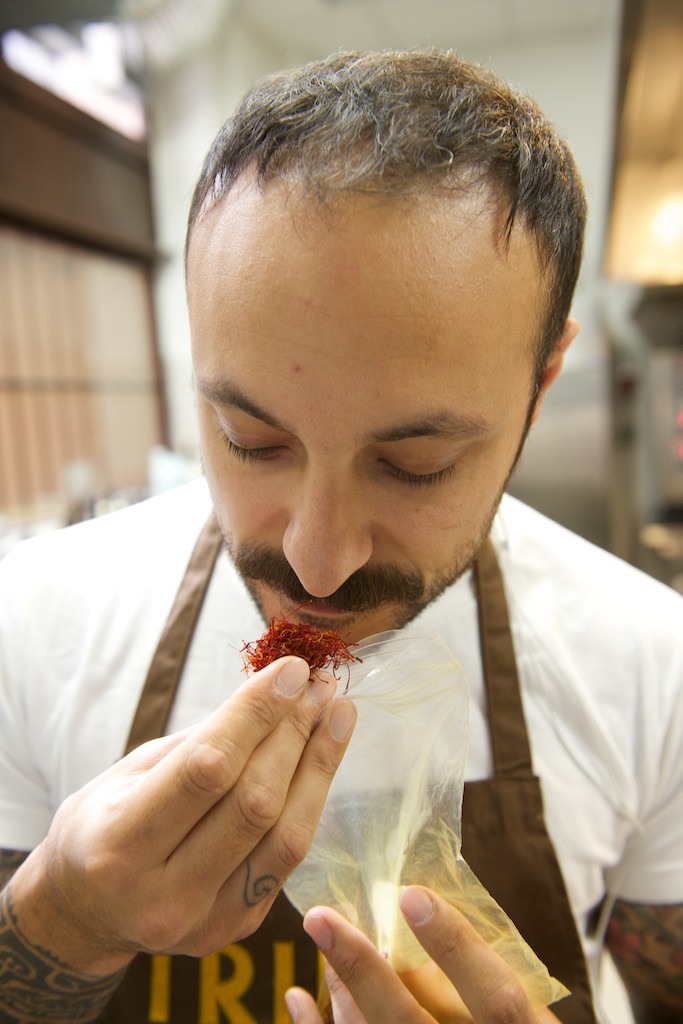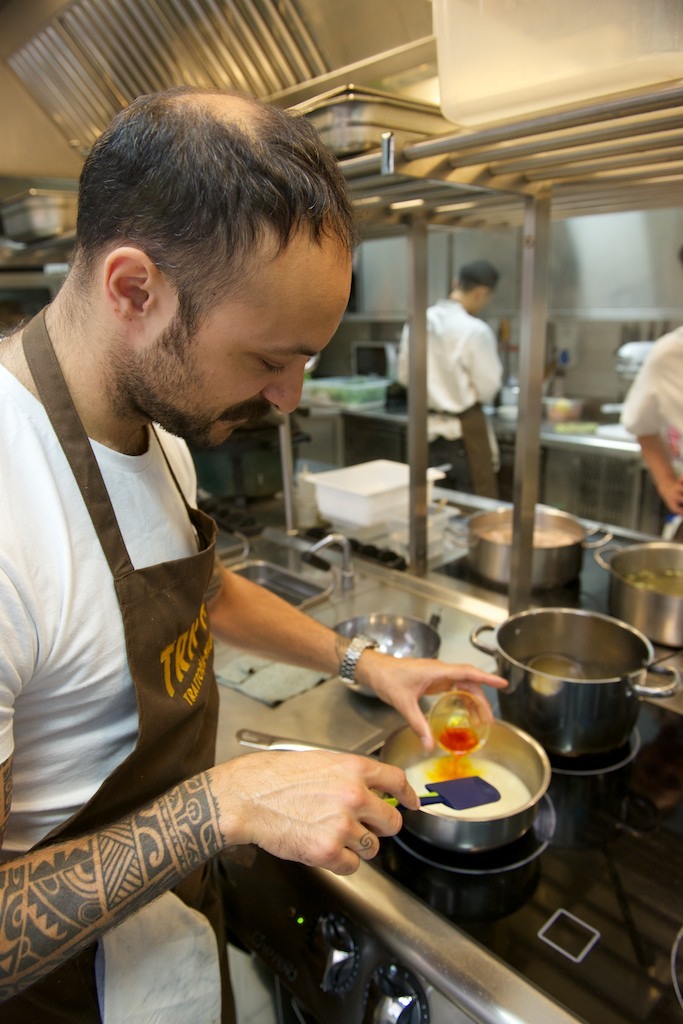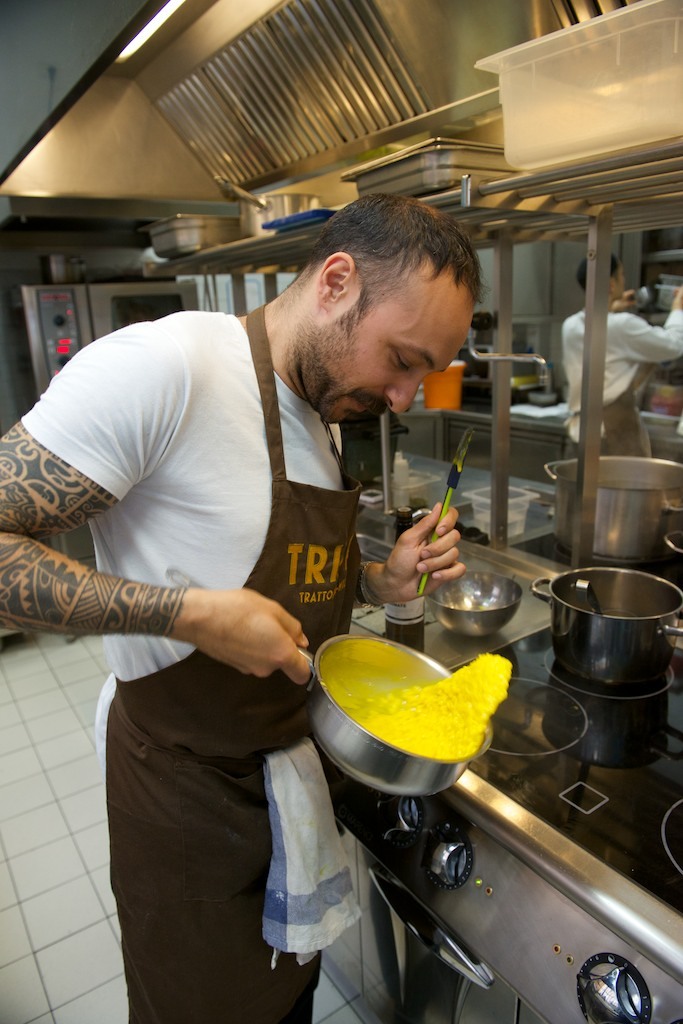An empty restaurant is a bad sign. So when I walked into Trattoria Masuelli San Marco, off a deserted drag that cuts through Milan, the urge to spin and walk was strong. But I’d traversed three countries over 28 hours to try their risotto. I was committed.
The glow of rainbow-glassed mid-century modern chandeliers. The glint of a giant brass espresso maker perched on the steel and wood bar. None of it warmed the eerie silence of being alone in a restaurant that looked a bit too much like your great aunt’s parlor crossed with a Chianti bottle.
My worry was wasted. All the warmth needed to melt the solitude arrived on a single white plate. A brilliant marigold pool of toothy-tender rice, the creamy liquid flecked with bold streaks of red. It was—simply—the taste of sunshine in my mouth. It was creamy without feeling heavy. The grains of rice were distinct, not gummy. It was looser, saucier than I’m used to. Wonderfully so. And those red filaments—the saffron—an aroma as much as a flavor.
By meal’s end, my error was obvious. Risotto alla Milanese—the saffron-tinged dish of creamy rice flavored floral and dyed golden by the thread-like stigmas and styles of crocus flowers—is a centuries-old tradition. And the trattoria’s staff had stayed open long beyond closing merely so I could try it.
Like all risotto, Milan’s golden rendition is notoriously fussy to make, often delivering uninspired results. Heat the broth. Chop the onion. Toast the rice. Soften the onion. Cook off the wine. Slowly stir. Stir. Stir. Keep going. You’ll get there. Finish with Parmesan. Only to get starchy, gluey rice that is simultaneously—puzzlingly—both over- and under-cooked.
My suspicion that there had to be a better way is what brought me to Milan, Italy’s northern center of fashion, design and risotto. I simply didn’t expect to find it on my first night.
But the risotto at Trattoria Masuelli San Marco was one of those meals that lingers in taste memory, so much so that it drew me back the following night, at the expense of another reservation elsewhere. Father and son—chef and front-of-the-house—Max and Andrea Masuelli welcomed me into the kitchen at the height of a bustling dinner rush.
Lesson No. 1: Forget everything you think you know about risotto-making. When the senior Masuelli took to the stove, risotto was made with blistering speed. Twenty minutes, give or take. This was no slow simmer with tiresome stirring, gently and slowly ladling in broth and waiting for it to be absorbed. This was dump-and-go risotto cooked at a rollicking boil.
Lesson No. 2: Ingredients I considered essential to risotto—chicken broth and onion—were nowhere to be seen. Translating for his father, Andrea explained that they preferred a simple vegetable broth (and much more of it than I expected) made on the spot—onions, carrots, celery and water—for a cleaner, simpler flavor that didn’t compete with the rice and saffron. Ditto for onion in the risotto. Its flavor detracts from the simplicity of the other ingredients, so they leave it out.
As a result, the cooking was fast and simple. Max began by steeping a generous pinch—more than a teaspoon—of saffron in ¼ cup of warm broth, the liquid quickly bleeding red.
Meanwhile, he briefly toasted a large handful of carnaroli rice—the preferred white risotto rice in Milan; elsewhere in Italy, it’s Arborio—in a bit of fat, then added ½ cup of room-temperature white wine, the source of the acidity that balances the richness of the rice starch and cheese. He brought it to a simmer. In a minute or so, the alcohol had cooked off and he ladled in the broth. All of it. All at once.
Back to a strong simmer, and it was mostly hands off. A bit of stirring and dramatic flipping every few minutes, but none of the constant motion or gentle heat I’ve always been told is essential for extracting the starch that produces risotto’s classic creamy texture. When the rice was nearly al dente—“white at the center, transparent at the edges,” Max explained—he added the saffron-infused broth, then stirred vigorously for several minutes, the rice darkening in stages from pale yellow to light orange to deep golden.
Off the heat, the finishing flourishes were added. Grated Parmesan and room-temperature butter—as with the wine, cold ingredients cool the rice too quickly—were stirred in, giving the risotto richness as it flowed loosely, cleanly onto a plate. In a move I learned is classic Milanese, Max held the edge of the plate with his left hand, then smacked the bottom of it repeatedly and firmly with his right palm, leveling the risotto into an even, glistening pool.





Several nights later, my education in shortcut—yet stellar—risotto again continued unexpectedly. I wheedled my way into the kitchen at Trippa, where the heavily tattooed Diego Rossi—known for maximizing flavor with minimal ingredients, as well as for a gorgeously crisp fried tripe—agreed to show me his take on risotto alla Milanese.
Lesson No. 1: The Masuellis were onto something. Rossi shared their preference for vegetable broth and disdain for onion. In fact, much of the way he cooked risotto mirrored their own—the saffron added at the end, the speed of the cooking, the infrequent stirring, the loose sauciness from extra broth, the gorgeous brightness and lightness of the color and flavors.
But something was different. Everything was heightened somehow. The flavors more crisp, the sauce somehow more luxurious, the butter and Parmesan almost popping.
Lesson No. 2: We weren’t done paring away classic ingredients. Along with the onion and chicken broth, Rossi also leaves out the wine. All we want is its acidity, but to get that you need to cook off the alcohol. Even then, the wine too often leaves behind a booziness that muddles the other flavors. So Rossi cuts out the middle, brightening his risotto not with wine, but with a finishing splash of sherry vinegar. He had me try the risotto before and after adding it; the difference was astounding.
At Milk Street, we found that the science supported these quick-cook methods. Because most of the starch is on the exterior of the rice, much of it is released at the start of cooking, regardless of whether the liquid is added all at once or gradually. The key is the initial vigorous stirring, which helps that release. After that, frequent—but not constant—stirring is all that’s needed to prevent the rice from sticking. And because there is no need to slowly extract the starch, the rice can be cooked at a higher temperature, resulting in a speedier risotto.
Encouraged by this, we adopted Rossi’s use of vinegar over wine and made only minor modifications to the rest of the recipe—bolstering the basic vegetable broth by adding just a single clove of garlic and chopped plum tomato, as well as using about 1 cup more of it in the risotto than is conventional; easing up just a bit on the amount of saffron used (which some people can find overwhelmingly floral at higher amounts).
The result was a seven-ingredient risotto that was light, bright, on the table in just 25 minutes—and well worth dining alone for.





